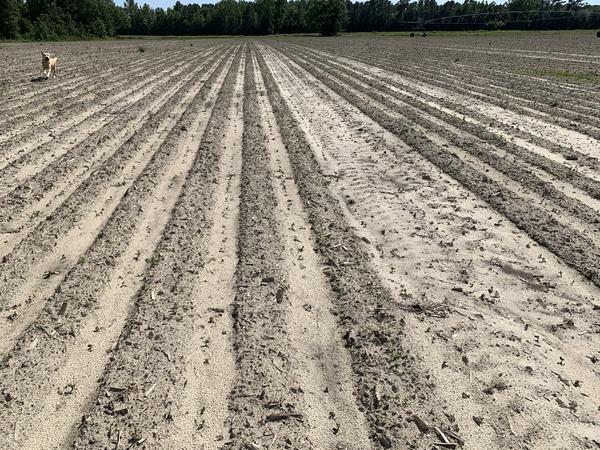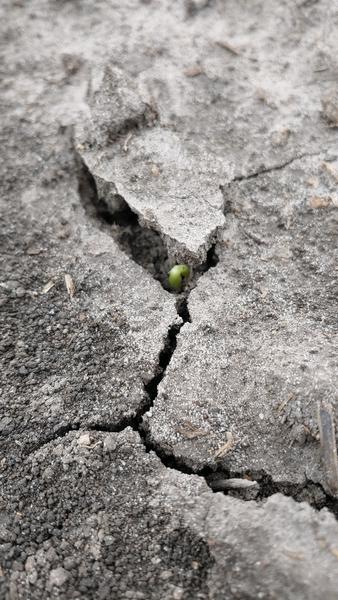Introduction
Soil crusting is a problem that can occur after soybean planting before the soybeans have emerged. Soybeans have epigeal emergence; this means that the hypocotyl arch needs to pull the cotyledons through the soil surface and unfavorable soil conditions from crusting can prevent this. The most common cause of crusting in North Carolina soybeans is physical crusting due to structural degradation at the soil surface. Finer textured soils with low organic matter that are historically cultivated and have minimal residue are more prone to crusting. Crusting is also more likely following a heavy rainfall event when the heavy rainfall can cause soil aggregates to move into the open pore space ultimately causing cementing of the soil. Limited rainfall after the heavy rainfall event can intensify the chance for soil crusting. Soil crusting causes soybeans to use all their energy trying to emerge from the soil and can ultimately result in an unacceptable stand or kill the plants if the issue is not addressed.
Symptoms
A physical crust may be observed. If a severe crust has formed, limited or uneven soybean emergence will occur. Swelling of the hypocotyl may be evident. Broken and damaged hypocotyls and cotyledons can be observed under the soil surface.
Management
If you are on crust-prone soils, several management strategies can be implemented at planting in an effort to minimize the issue. On soils prone to crusting, you need to make sure you are not planting soybeans too deep. The deeper soybeans are planted, the more difficult it is for them to break the crust while emerging because they must expend more energy trying to emerge from greater depths. Higher seeding rates can be used in fields prone to crusting so the soybeans can use the emergence force from one another to break the crust. Closer seed spacing in wider rows can also help break a crust compared to a similar population on narrower row spacing. Growers with crust-prone fields should avoid planting soybeans when soil temperatures are below 60℉ because these conditions can prolong emergence and allow more time for a crust to form.
If a crust does form, growers can break the crust with some type of shallow tillage implement, such as the rotary hoe. The shallow tillage should occur only deep enough to break the crust but not deep enough to cause excessive seed damage. Running the tillage implement too deep will result in unacceptable crop damage. Some seed damage is expected as variation in emergence progress across the field is likely. Operating the equipment in the same direction the rows were planted can help minimize crop damage. If soybeans are in the crook stage, they are most susceptible to damage from the rotary hoe. Growers should stop and check frequently during the tillage process to assess crop damage and decide if adjustments need to be made.
Longer-term management strategies include increasing residue on the soil surface which helps with aggregate stability following heavy rainfall events and improving soil structure (ie increasing organic matter, limiting cultivation) through long-term management.
Additional Resources
Soil Crusting (PennState Extension)
Improving soybean emergence in soils prone to crusting (MSU Extension)
Soil crust-busters (Iowa State University Extension and Outreach)
Publication date: June 1, 2020
N.C. Cooperative Extension prohibits discrimination and harassment regardless of age, color, disability, family and marital status, gender identity, national origin, political beliefs, race, religion, sex (including pregnancy), sexual orientation and veteran status.
NC Cooperative Extension prohíbe la discriminación por raza, color, nacionalidad, edad, sexo (incluyendo el embarazo), discapacidad, religión, orientación sexual, identidad de género, información genética, afiliación política, y estatus de veteran.
The use of brand names in this publication does not imply endorsement by NC State University or N.C. A&T State University of the products or services named nor discrimination against similar products or services not mentioned.
Recommendations for the use of agricultural chemicals are included in this publication as a convenience to the reader. The use of brand names and any mention or listing of commercial products or services in this publication does not imply endorsement by NC State University or N.C. A&T State University nor discrimination against similar products or services not mentioned. Individuals who use agricultural chemicals are responsible for ensuring that the intended use complies with current regulations and conforms to the product label. Be sure to obtain current information about usage regulations and examine a current product label before applying any chemical. For assistance, contact your local N.C. Cooperative Extension county center.
N.C. Cooperative Extension prohibits discrimination and harassment regardless of age, color, disability, family and marital status, gender identity, national origin, political beliefs, race, religion, sex (including pregnancy), sexual orientation and veteran status.



